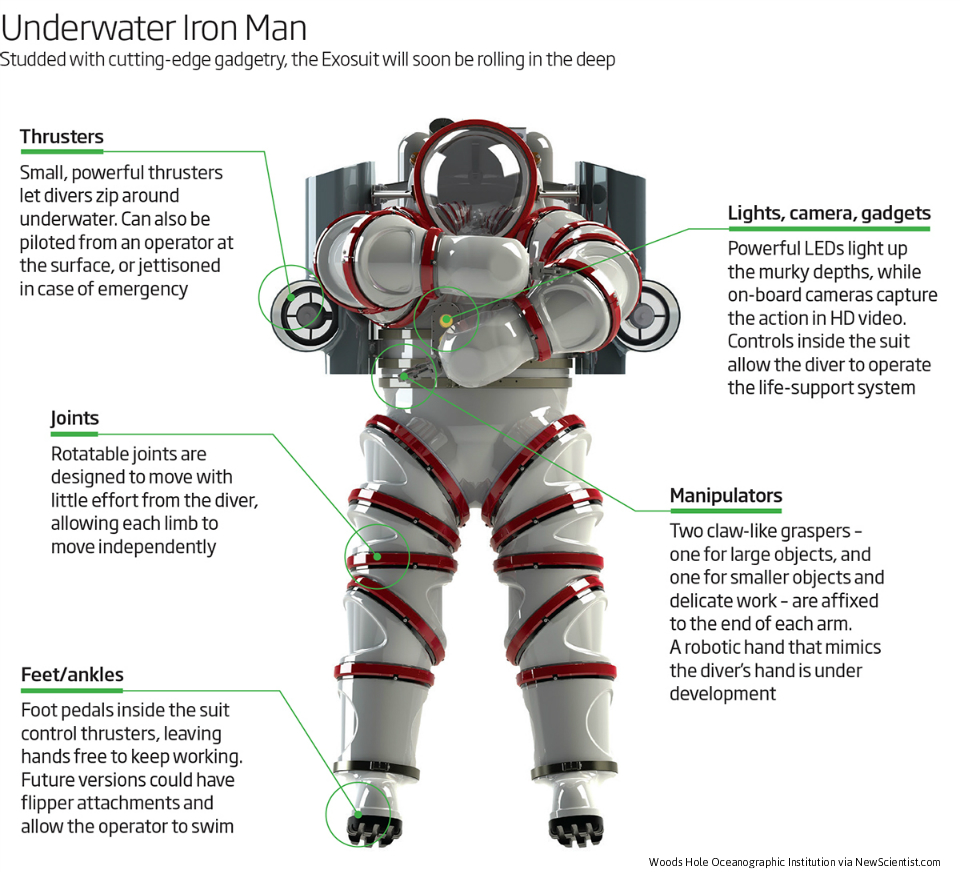Filtered by: Scitech
SciTech
Real-life Iron Man to track down 2,000-year-old computer
It reads like something straight out of a comic book, but this time it's very real.
Scientists have designed a wearable submarine that may be the closest thing yet to an actual Iron Man suit.
Scientists have designed a wearable submarine that may be the closest thing yet to an actual Iron Man suit.
advertisement
Even more amazing is the purpose of the suit: it's built specifically to hunt down clues to the origins of a computer older than Jesus Christ.

Dubbed simply Exosuit, the robotic suit will be worn by a diver who will search the wreck of an old Greek vessel to look for a 2,000-year-old computer, New Scientist reported.
"It's basically a wearable submarine," Phil Short, a diving specialist on the planned mission to Antikythera, said of the $1.5-million suit.
He added the pressure inside the suit "is no different from being in a submarine or in fresh air."
"We can go straight to the bottom, spend 5 hours there and come straight back to the surface with no decompression," he said.
Built by marine robotic firm Nuytco Research in North Vancouver, the suit was sold to civil engineering company J. F. White, which used it in New York City.
Like the Iron Man suit, Exosuit has a rigid metal humanoid form - along with thrusters that let divers go as far as 300 meters underwater.
The suit had its first tests in seawater at the Woods Hole Oceanographic Institution (WHOI) in Massachusetts, New Scientist said.
Its first scientific mission will be in July, when a team from the American Museum of Natural History will dive in the Canyons—160 km off the northeast US coast—to look for bioluminescent organisms.
World's oldest computer
Its first scientific mission will be in July, when a team from the American Museum of Natural History will dive in the Canyons—160 km off the northeast US coast—to look for bioluminescent organisms.
World's oldest computer
But what could be the Exosuit's first real test will be to excavate an ancient shipwreck off Antikythera in the Aegean Sea to look for a second "Antikythera mechanism," considered the world's oldest computer.
The Antikythera wreck, discovered by Greek sponge fishermen in October 1900, is 120 meters underwater, giving divers little time to explore it.
It was not until the 1950s that scholars figured out the wreck—which had fragments of a geared device—could be a sophisticated computer that can predict astronomical events.
"With the Exosuit, our bottom time becomes virtually unlimited," said Brendan Foley, co-director of field operations at WHOI's Deep Submergence Laboratory.
"Now we can have an archaeologist in the suit for hours, and we'll only have to come up to answer the call of nature," he added.
Archaeologists expect to use the Exosuit's manipulators to get through silt, marine life and centuries of debris.
However, the suit will be on loan to the Antikythera wreck exploration for just "a week or two," the report said.
Suit vs. scuba
While marine archaeologists usually wear scuba gear to explore underwater sites, they face the risk of decompression sickness if they spend too much time underwater.
Researchers instead use remotely operated vehicles (ROVs) with carrying cameras and sonar to scan a deep underwater area.
In some cases, they use large expensive craft like the Alvin submarine, which explored the wreck of the Titanic in 1986.
The suit's 'armaments'
The suit is made of aluminium alloy, with articulated joints.
But unlike Iron Man's suit, it needs an umbilical cable from a ship to get power for horizontal and vertical thrusters, and a rebreather that can give 50 hours of life support.
Also, the cable contains voice, video and data links.
Meanwhile, foot pedals control the four thrusters for navigation while a video feed allows an operator aboard a ship to take over and recover the suit.
Fine-tuning the suit
However, New Scientist said the suit is not without its problems, at least in saltwater.
Initial tests in saltwater included electrical problems that overloaded the thrusters.
Also, customizing the suit for different divers takes much time.
"It's an experimental suit. We need to figure out what it can do for us and how to make it as effective as possible. All we can do is get down there, get close to the sediment and map out the debris field with our metal detectors. Over a period of meticulous seasons, we'll slowly close in on what we hope is another mechanism," said Foley. — Joel Locsin/TJD, GMA News
Find out your candidates' profile
Find the latest news
Find out individual candidate platforms
Choose your candidates and print out your selection.
Voter Demographics
More Videos









